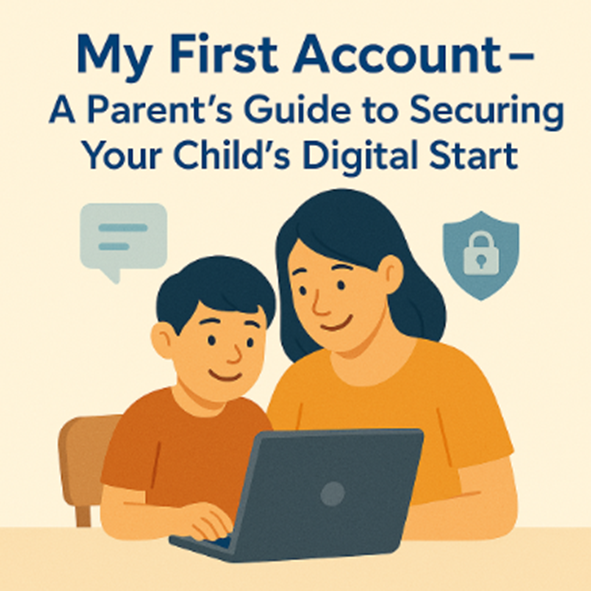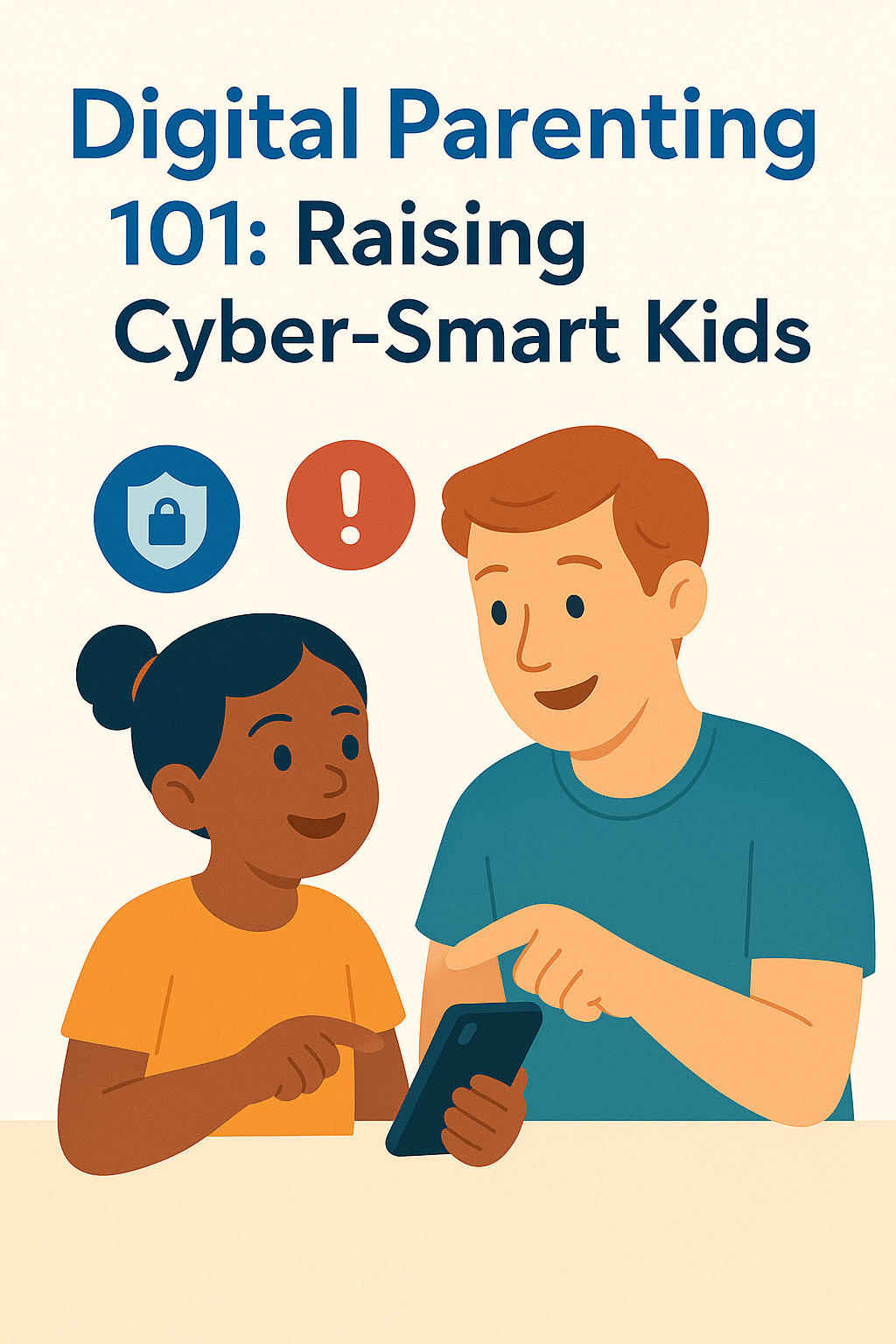Digital Parenting 101: Raising Cyber-Smart Kids
In today’s world, a child’s playground doesn’t always have a swing set—it often glows from a screen. From video games to social media, the digital...
5 min read
Roberto Ishmael Pennino & Liam Stock-Rabbat : Jul 7, 2025 7:00:00 AM

There are many certainties in life – death & taxes. But for every parent, there’s also the moment their child asks you to help them create their first account. Whether it’s to access an online math game, a messaging app, or a digital classroom, that first account is more than just a username—it’s the start of your child’s online presence. And while that can feel like a daunting step, it’s also a powerful opportunity to build healthy, safe digital habits right from the beginning.
This is the inspiration for this guide. From selecting the right age-appropriate platforms to protecting their privacy and fostering an open dialogue, this guide is here to help you set them up with a safer, smarter digital start to their initiations to the internet.
Not all apps and websites are designed for children in mind. This reminder is key as it's imperative to identify those age-appropriate platforms from the get-go. Sites and apps designed for younger users typically offer simplified interfaces, stronger privacy defaults, and a concerted effort towards promoting educational content. Typically, platforms with COPPA (Children’s Online Privacy Protection Act) compliance are a good place to begin for kids under 13. There are many lists online compiling COPPA compliant sites with links to each site’s privacy policy.
Remember, always review privacy policies and app permissions before setup and avoid platforms that collect too much personal data, have minimal moderation, or allow contact with strangers.
The time has finally come. Where do you start? Start by treating the creation of this first account a joint project with your child. Sit down together, go through the process together, explain what a username and a password are and take the opportunity to explain each step.
On the topic of passwords, make sure to start with a strong and memorable password. Often, this password may go onto being one of your child’s main passwords for the rest of their lives, so make sure to avoid names, birthdays, or pet names. In this case, always remember that longer is better! Try using a passphrase, a couple favorite words with a combination of numbers. Keep it memorable, but make sure it’s something others wouldn’t be able to guess.
Furthermore, if possible, make sure to use a parent-managed email address for account recovery and alerts. This keeps you in the loop and prevents scams from reaching your child directly.
Lastly, be certain to enable two-factor authentication (2FA) whenever it’s available. Many platforms now support it, and it adds an essential layer of protection in this day and age. Without getting too technical, explain the concept using a metaphor such as the idea of a second key to one’s digital house – you don’t want to let strangers in as it’s something only you and your child have access to. This will let your child know that a simple password is no longer sufficient.

Setting up that first account is more than a tech task—it’s a moment to build trust, share knowledge, and start healthy online habits side by side.
Most platforms encourage their users to ‘complete’ their profiles with as much personal information as possible. Be it a profile photo, a birthdate, a locate or even gender, this is the type of data is precious and should be kept to oneself.
Although sites destined to children tend to ask a little less of these types of data, it’s imperative to keep profile details to a minimum. Avoid using real names, birthdays, school names or locations. Choose avatars instead of real photos and skip adding bios that reveal too much to wandering eyes.
When possible, disable location tracking and limit visibility. Make accounts private, restrict who can see posts or friend requests, and review settings regularly—especially after updates, which can reset defaults.
Talk about “friend” requests—what’s okay, what’s not, and why it’s important to know (in real life) who you’re connecting with online. Unlike the playground or classroom, the internet gives strangers easy ways to appear friendly, trustworthy, or even familiar. That’s why it’s critical to talk about friend requests and online connections—before they start accepting them.
Emphasize that it’s always okay to say no to a request—and they should ask you before accepting anyone they’re unsure about.
On the topic of friend requests, you can also address ‘friends management’. You should take a moment to show your child how and when to block or report users, especially if they don’t trust the person on the other side of the screen. Likewise, you should highlight the importance of having a smaller list of known, trusted contacts is way better than collecting “followers” you don’t know.
Another important lesson to bring up is the concept of digital footprint. It’s imperative to teach your child that everything they do online leaves a trail. You should introduce the concept of online permanence, that is the idea that everything is recorded – even when you might not expect it, early on so that they understand they should pause before they post.
Explain that digital artifacts such as screenshots, search histories, and shared messages can live on long after the original post is gone. Ask them to imagine: “Would you be okay if your teacher, grandparent, or a stranger saw this?” Make it a conversation, do not lecture them. Use examples from your own life or illustrate it with examples on your own account, e.g., an old Facebook or Instagram post.
As kids take their first steps into digital spaces, it’s natural to want to keep a close watch over them. But, as all of us know, constant surveillance often backfires which in turn leads to secrecy, resentment, or fear of getting in trouble (our children and colleagues aren’t too difference when you think about it) The better path? Active involvement with a light touch.
Your goal isn’t to control their every action—it’s to create a safe, transparent environment where your child feels comfortable talking to you about what they’re seeing and doing online.
Start by setting expectations early:
“I’m not going to read every message or spy on you. But I will stay involved to help you stay safe.”
The use of parental dashboards, family link apps, or built-in device controls to understand overall usage patterns is imperative. It allows you as a parent to what platforms they use most, how much time they’re spending online, and whether any new apps are popping up. Many tools also allow you to set screen time limits, restrict downloads, or receive alerts for unusual activity.
Be upfront about these tools. Explain that they’re like training wheels—not a punishment. When kids know what’s being monitored and why, they’re more likely to trust your involvement instead of hiding their behaviour.
You can also build routine check-ins by asking questions such as:
These regular, casual conversations help normalize openness. Your child will learn that you’re someone they can talk to, not just someone watching from the sidelines.

Instead of monitoring from afar, being present and approachable encourages children to share their digital experiences without fear or shame.
Over time, as they grow and show responsibility, you can gradually loosen controls—just like you would with bedtime or curfews. Remember, the long game is about self-regulation, digital resilience, and mutual trust.
Unfortunately, even with good security habits, things can go wrong. Let your child know in advance so that they can expect the unexpected and know what to do if ever such situations materialise.
Make sure to them something of the sorts: “If something makes you feel weird, tell me right away – you won’t get in trouble.” Whether it’s a stranger message, an upsetting video, or a game that suddenly feels toxic, the goal is to normalize asking for help and bringing up inappropriate requests or situations. Likewise, be sure to show them how to report inappropriate content or users on each platform.
Some Final Thoughts
Creating one’s first account is a big milestone. It’s an online rite of passage of sorts. It’s a sign your child is growing up. By acting on this critical moment and guiding them through it together, you’re giving them the confidence and skills they need to be thoughtful, secure and responsible digital citizens. It’s in these moments that we can have the biggest impact. Indeed, it's not about protecting them forever, but rather preparing them for success. You don’t need to be a tech expert to make a difference.
You just need to stay curious, stay involved, and support constant empowerment.

In today’s world, a child’s playground doesn’t always have a swing set—it often glows from a screen. From video games to social media, the digital...